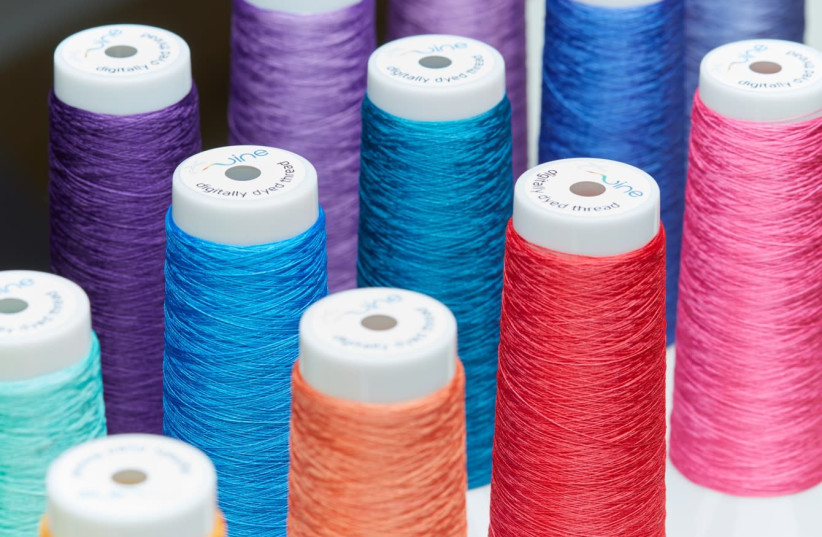Vegans won’t eat anything from a living creature, but how about wearing them or using objects made from them? Researchers at Imperial College London have genetically engineered bacteria to grow animal- and plastic-free leather that dyes itself.
Environmental concerns are driving interest in post-petroleum synthetic textiles produced from microbial and fungal sources. Bacterial cellulose (BC) is a promising sustainable leather alternative, on account of its material properties, low infrastructure needs and biodegradability. However, for alternative textiles like BC to be fully sustainable, alternative ways to dye textiles need to be developed alongside alternative production methods.
In recent years, scientists and companies have started using microbes to grow sustainable textiles or to make dyes for industry – but this is the first-time bacteria have been engineered to produce a material and its own pigment at the same time. Synthetic chemical dyeing is one of the most environmentally toxic processes in fashion, and black dyes – especially those used in coloring leather – are particularly damaging. The British researchers set out to use biology to solve this problem.
The researchers, who have just published their findings in the prestigious journal Nature Biotechnology under the title “Self-pigmenting textiles grown from cellulose-producing bacteria with engineered tyrosinase expression,” say their self-dyeing vegan, plastic-free leather is a step forward in the quest for more sustainable fashion. The synthetic material has already been fashioned into shoe and wallet prototypes.
Their new process could also theoretically be adapted to have bacteria grow materials with various patterns and vibrant colors and to make more sustainable alternatives to other textiles such as cotton and cashmere.

'A major achievement for synthetic biology'
The lead author, bioengineering Prof. Tom Ellis, said: “Inventing a new, faster way to produce sustainable, self-dyed leather alternatives is a major achievement for synthetic biology and sustainable fashion. Bacterial cellulose is inherently vegan, and its growth requires a tiny fraction of the carbon emissions, water, land use and time of farming cows for leather.”
Unlike plastic-based leather alternatives, bacterial cellulose can also be made without petrochemicals and will biodegrade safely and non-toxically in the environment, he continued.
The researchers created the self-dyeing leather alternative by modifying the genes of a bacteria species called Komagataeibacter rhaeticus to create a bacterial strain that grows self-pigmenting BC that produces sheets of microbial cellulose – a strong, flexible and malleable material that is already commonly used in food, cosmetics, and textiles. The genetic modifications “instructed” the same microbes that were growing the material to also produce a dark black pigment called eumelanin.
They worked with designers to grow the upper part of a shoe (without the sole) by growing a sheet of bacterial cellulose in a shoe-shaped vessel. After 14 days of growth, during which the cellulose took on the correct shape, they subjected the shoe to two days of gentle shaking at 30°C to activate the production of black pigment from the bacteria so that it dyed the material from the inside. They also made a black wallet by growing two separate cellulose sheets, cutting them to size, and sewing them together.
In addition to the prototypes, the researchers demonstrated that the bacteria can be engineered using genes from other microbes to produce colors in response to blue light. By projecting a pattern or logo onto the sheets using blue light, the bacteria respond by producing colored proteins that then glow. This allows them to project patterns and logos onto the bacterial cultures as the material grows, resulting in patterns and logos forming from within the material.
Co-author Dr. Kenneth Walker, who conducted the work at Imperial College London’s bioengineering department and now works in industry, said: “Our technique works at large enough scales to create real-life products, as shown by our prototypes. From here, we can consider aesthetics as well as alternative shapes, patterns, textiles, and colors. The work also shows the impact that can happen when scientists and designers work together. As current and future users of new bacteria-grown textiles, designers have a key role in championing exciting new materials and giving expert feedback to improve form, function, and the switch to sustainable fashion.”
The researchers are now experimenting with a variety of colored pigments to use those that can also be produced by the material-growing microbes. The researchers and collaborators have also just won £2 million in funding from the Biotechnology and Biological Sciences Research Council, part of UK Research and Innovation, to use engineering biology and bacterial cellulose to solve more of fashion’s problems, such as the use of toxic chromium in leather’s production lines.
“Microbes are already directly addressing many of the problems of animal and plastic-based leather, and we plan to get them ready to expand into new colors, materials, and maybe patterns too,” Ellis concluded. “We look forward to working with the fashion industry to make the clothes we wear greener throughout the whole production line.”
